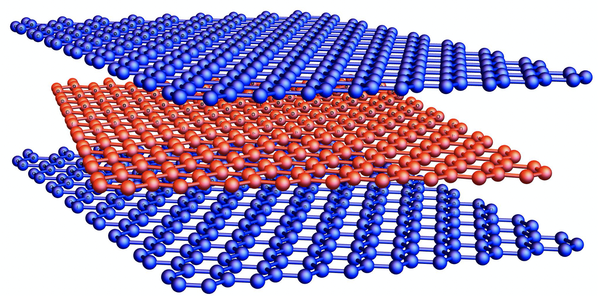Researchers are looking into materials with several layers in the search for new types of superconductors, which are phases of matter that transmit electric charge without distortion. The features of a system of three twisted graphene layers were explored in depth by a team headed by Mathias Scheurer from the University of Innsbruck, Austria, and significant insights were acquired.
 Honeycomb-shaped structures made of carbon atoms, known as graphene, can conduct electric current without resistance when twisted against each other. Image Credit: University of Innsbruck
Honeycomb-shaped structures made of carbon atoms, known as graphene, can conduct electric current without resistance when twisted against each other. Image Credit: University of Innsbruck
Graphene has garnered the interest of researchers since the first successful manufacturing of a two-dimensional structure of carbon atoms nearly 20 years ago. Scientists discovered several years ago that two layers of graphene might transmit electric current without distortion when they are gently bent against each other.
This finding has spurred scientists to investigate layered materials in greater depth. Mirror-symmetric twisted trilayer graphene, in which three layers of graphene are layered with alternate twist angles, is a significant example. The first moiré system can be controlled effectively with a perpendicular electric field and has been shown to display strong superconductivity, as well as other phases, practically.
This establishes trilayer graphene as an exciting platform for complex many-body physics, but the nature of the observed interaction-induced insulators, semi-metals, and superconductivity remains unknown.
Mathias Scheurer, Theoretical Physics, University of Innsbruck
A team headed by Scheurer examined the phase diagram of this system practically and theoretically for differing amounts of electrons per moiré unit cell and as a function of an electric field. The study was published in the journal Physical Review X.
With the property that has successively been confirmed by experiments, Scheurer states, “This is a very challenging problem as the system has both flat and highly dispersive bands. Nonetheless, we managed to show that the ground state of the system in the absence of a field decouples into a product of the ground state of graphene and the ground state of twisted bilayer graphene.”
Their findings also show that in the presence of an electric field, insulating and semi-metallic phases dominate, which is peculiar to the trilayer structure and not seen in twisted bilayer graphene.
We are able to use our resulting phase diagram for the correlated normal states to constrain the form of the superconductor. Among other aspects, the resulting two superconducting candidate states we get are consistent with the unexpected stability of the superconductor in the magnetic field seen in the experiment.
Mathias Scheurer, Theoretical Physics, University of Innsbruck
A consecutive partnership with the Columbia University group of Abhay Pasupathy attests to the significance of the results for the physics of twisted trilayer graphene. They describe scanning tunneling microscopy (STM) data on this system in a recent study in Science.
“We show that the measured tunneling spectra exhibit significant interaction effects that can be qualitatively captured by the numerics of our work,” concludes Scheurer.
Journal Reference:
Christos, M., et al. (2022) Correlated Insulators, Semimetals, and Superconductivity in Twisted Trilayer Graphene. Physical Review X. doi.org/10.1103/PhysRevX.12.021018.
Source: https://www.uibk.ac.at/en/